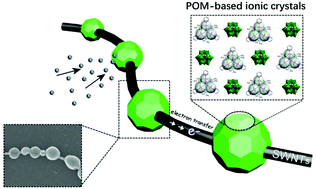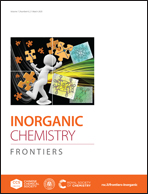Fabrication of redox-active polyoxometalate-based ionic crystals onto single-walled carbon nanotubes as high-performance anode materials for lithium-ion batteries†
Abstract
Polyoxometalate (POM)-based molecular cluster batteries have attracted wide interest due to their rich redox properties. To date, no studies on POM-based ionic crystals for LIBs have been reported, although the redox-active metals can be incorporated and finely tuned in the ionic crystals. Herein, a POM-based ionic crystal (denoted as Composite 1) was prepared for the first time by the complexation of the trinuclear acetate-bridged cobalt-containing macrocation ([Co3O(CH3CO2)6(C5H5N)3]+) with the anion [PMo12O40]3−. Further interaction of Composite 1 and single-walled carbon nanotubes (SWNTs) resulted in the formation of a novel Composite 1/SWNT nanocomposite through a facile one-pot strategy, in which the Composite 1 clusters were uniformly grown onto the surface of SWNTs. The as-prepared Composite 1/SWNT nanocomposite showed outstanding electrochemical performance as an anode material of LIBs by delivering a storage capacity of 1012 mA h g−1 at 100 mA g−1 for 100 cycles. The results may open a new pathway for exploring novel anode materials of LIBs.



 Please wait while we load your content...
Please wait while we load your content...